How I Get My Protein
The first question people generally ask vegans is, "Where do you get your protein?"There are PLENTY of protein sources in the plant world. Here's a brief list:--nuts: almonds, walnuts, cashews, etc.--seeds: chia, pumpkin seeds, flaxseed, sesame, sunflower, hemp...--beans and legumes: lentils, chickpeas, soybeans/tofu, kidney beans, peas...--vegetables: broccoli, asparagus, cauliflower, watercress, corn, brussels sprouts...--mushrooms: portobello, maitake, etc.--quinoa--nutritional yeastSure, you get protein from meat and dairy products, but you also get lots of saturated fat, cholesterol, hormones, and chemicals, all of which are known to promote cancer, heart disease, and diabetes. Protein from plants is therefore highly preferable to animal sources.Perhaps the next question a meat-eater will ask is, can you get enough protein solely from plant sources? First of all, you don't need as much protein as you think you do; as T. Colin Campbell says in The China Study:
"We do not need #protein in excess of what is provided in a normal, whole-food, plant-based diet." @TColinCampbell
-- Victoria Moran (@Victoria_Moran) August 9, 2013
To show you I get plenty of protein on a vegan diet, I measured and tallied up everything I ate on August 15, 2013, waiting until afterward to figure out my ideal protein intake (so you don't have to wonder if I changed anything about my diet for the sake of the experiment).
I should also preface this demonstration by telling you that right now I'm living on a college campus and eating almost all my meals in the school dining hall. It isn't the most vegan-friendly eatery in the world, but I make do, and if I can get enough protein, vitamins, and minerals in this less-than-ideal situation, then so can you.This was a fairly typical day for me eating-wise, although I don't make it to breakfast if I'm going to a 9am yoga class. Last Thursday I was going to yoga at 4pm, so I had half a grapefruit, tea, and a healthy helping of oatmeal with raisins and almond milk. (They do usually have almond milk, bless them. And yes, I did bring a measuring cup to the dining hall!):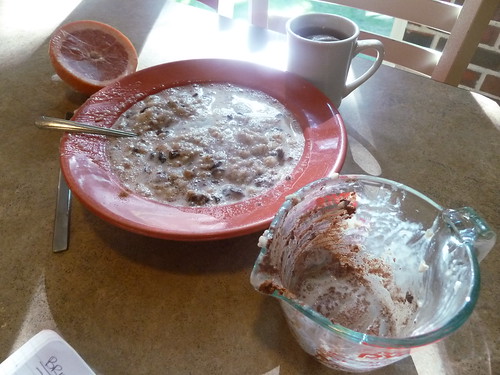 At lunchtime there was quite a bit of curiosity and amusement among my friends-slash-colleagues when I sat down to measure my vegetables.
At lunchtime there was quite a bit of curiosity and amusement among my friends-slash-colleagues when I sat down to measure my vegetables.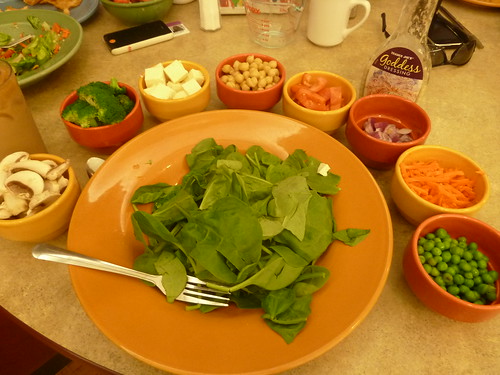 For lunch, I usually have a big salad with field greens or spinach, chickpeas, tomato, broccoli, tofu, peas, carrots, and onion, topped with hummus or some Goddess dressing from Trader Joe's if I have it (they have olive oil and balsamic vinegar in the dining hall, but this tahini dressing takes any salad from pretty good to thoroughly delicious.)
For lunch, I usually have a big salad with field greens or spinach, chickpeas, tomato, broccoli, tofu, peas, carrots, and onion, topped with hummus or some Goddess dressing from Trader Joe's if I have it (they have olive oil and balsamic vinegar in the dining hall, but this tahini dressing takes any salad from pretty good to thoroughly delicious.)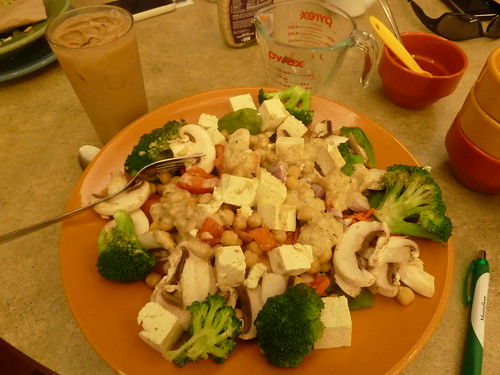 Did I really eat all that? Why yes, yes I did. It took me about forty minutes though, haha.
Did I really eat all that? Why yes, yes I did. It took me about forty minutes though, haha.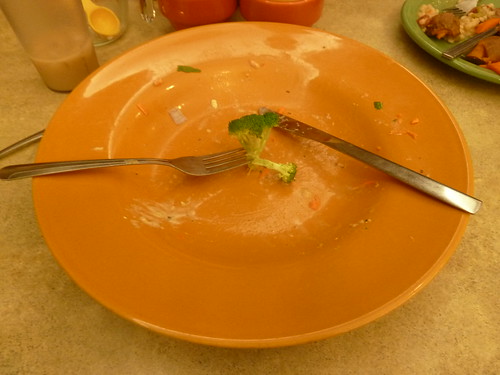 (And I ate that last piece of broccoli too.)
(And I ate that last piece of broccoli too.)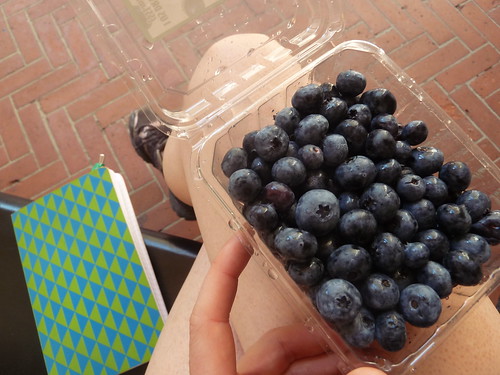 Then I snarfed down most of a pint of blueberries before yoga class.Since I was spending the evening knitting with Kath and Amy Lou, I grabbed a falafel sandwich and an organic carrot juice from Trader Joe's for a quick dinner (along with the last of the blueberries).
Then I snarfed down most of a pint of blueberries before yoga class.Since I was spending the evening knitting with Kath and Amy Lou, I grabbed a falafel sandwich and an organic carrot juice from Trader Joe's for a quick dinner (along with the last of the blueberries).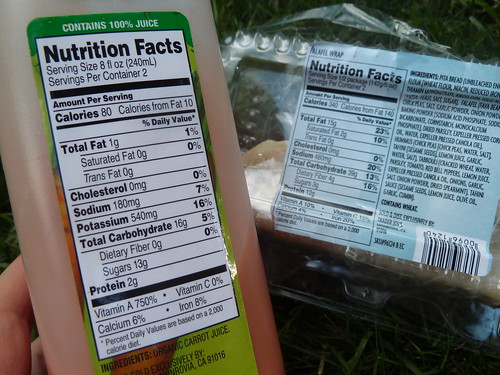 Check out how much protein I got in this sandwich: twenty-four grams!!! (And an additional 4 grams from the carrot juice.)
Check out how much protein I got in this sandwich: twenty-four grams!!! (And an additional 4 grams from the carrot juice.) And for a snack when I got home, half a cup of raw almonds and a banana.Then I tallied up the protein using either the food labels or the USDA National Nutrient Database:
And for a snack when I got home, half a cup of raw almonds and a banana.Then I tallied up the protein using either the food labels or the USDA National Nutrient Database: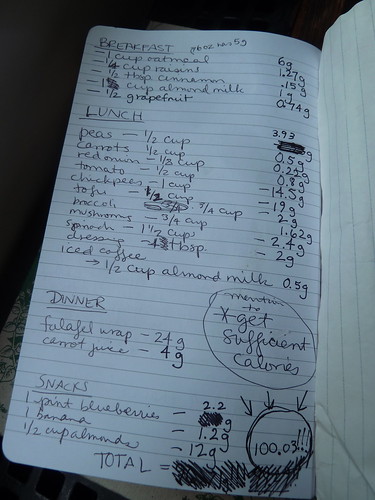 A hundred grams of protein!!! I was actually shocked when I added this up. I know I don't need anywhere near this much--and you can see how easy it was. But for the sake of thoroughness, let me figure out the recommended intake for my weight using the standard guideline as explained in Brenda Davis and Vesanto Melina's Becoming Vegan:
A hundred grams of protein!!! I was actually shocked when I added this up. I know I don't need anywhere near this much--and you can see how easy it was. But for the sake of thoroughness, let me figure out the recommended intake for my weight using the standard guideline as explained in Brenda Davis and Vesanto Melina's Becoming Vegan:
The protein in foods such as tofu, textured soy protein, meat substitutes, and refined grains is as digestible as that in animal products...Whole grains, beans, and vegetables have a tremendous range of health benefits, including an abundance of fiber, phytochemicals, trace minerals, and vitamins. At the same time, these foods are slightly less digestible than some of the more refined and processed plant foods. Thus, with diets composed of whole plant foods, some experts suggest that a factor of 10-15% be added to cover differences in protein digestibility. For vegans on predominantly whole foods diets, a figure of 0.9 g protein per kg body weight is suggested.
So to figure out how much protein you should be getting on a daily basis, just multiply your weight in kilograms by 0.9 (the U.S. RDA guideline is 0.8, by the way, so 0.9 is definitely erring on the side of caution). I weigh about 150 pounds (68 kg), so my protein recommendation is 61 grams. With an intake of 100 grams, even if I were pregnant I'd still be getting plenty of protein! I guess the real question to ask here isn't "am I getting enough?" but "am I getting too much?"--hilariously ironic given just how many times I've heard people ask how I can get enough protein on a vegan diet.I didn't tally up the calories, but if I got sufficient protein then it's safe to say I got enough. Something to keep in mind if you are transitioning to veganism: just make sure to EAT enough to satisfy yourself--enjoying healthy-fat foods like almonds (or almond butter), olive oil, and avocados--and you won't lose weight (unless you want to, of course; then you'd go easy on the olive oil!)